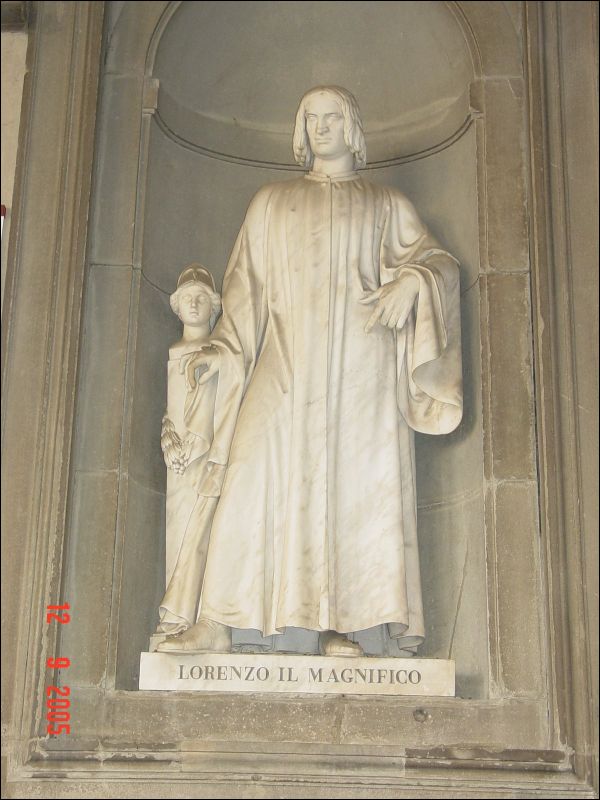Ark and Laura in Florence 2005 (118 of 172)
![[First]](bw_first.gif)
|
![[Prev]](bw_prev.gif)
|
![[Index]](bw_index.gif)
|
![[Next]](bw_next.gif)
|
![[Last]](bw_last.gif)
|

|
|
All along the collonnaded, narrow passage between the buildings of the Uffizi Palace were sculptures of important figures of Italian, most particularly, Florentine, history. The exact same name was also carried by his grandson Lorenzo (1492 - 1519), Duke of Urbino, with whom he is sometimes confused. Lorenzo di Piero de' Medici (January 1, 1449, Florence – 8 April 1492, Carregio) was an Italian statesman and ruler of the Florentine Republic during the height of the Italian Renaissance. Known as Lorenzo the Magnificent (il Magnifico) by his contemporary Florentines, he was a glittery individual who loved to enter tournaments, compose poetry and songs, play games, hunt, and indulge the Florentine love of practical jokes. Lorenzo had a very active life and was an avid patron of the arts; he was also fascinated by technology, was very religiousn, and deeply loved his country. He assumed a leading role in the state upon the death of his father Piero 'the Gouty' de' Medici in 1469, when Lorenzo was just twenty. On April 26, 1478, in an incident called the Pazzi Conspiracy, a group including members of Pazzi family, backed by the Archbishop of Pisa and his patron Pope Sixtus IV, attacked Lorenzo and his brother and co-ruler Giuliano in the cathedral of Florence, killing Giuliano. The conspiracy was brutally put down (against the express request of Lorenzo), including the lynching of the Archbishop. In the aftermath of the Pazzi Conspiracy and the punishment of the Pope's supporters, the Medici and Florence suffered from the wrath of the Pope. He seized all the Medici assets he could find, excommunicated Lorenzo and the entire government of Florence, and finally put the city under interdict. When that had little effect, the Pope formed a military alliance with King Ferrante of Naples to attack Florence. The King's son, Alfonso, Duke of Calabria, promptly invaded. The Florentines promptly excommunicated the Pope, and Lorenzo rallied the citizens. However, with little help being provided by traditional Medici allies in Bologna and Milan (the latter being convulsed by power struggles among the Sforza), the war dragged on, and only deft diplomacy by Lorenzo, who personally travelled to Naples, saved the day. This further increased his popularity with the Florentines, and enabled him to secure constitutional changes that enhanced his power. Thereafter, Lorenzo, like his grandfather Cosimo de' Medici, pursued a policy of maintaining both peace and a balance of power between the Northern Italian states, and keeping other states out of Italy. He also tried to create a more unified Italy but with little success. Another of Lorenzo's successes was in the fields of art and learning; he gathered at his court the leading artists and intellectuals of his day. His support for artists such as Leonardo da Vinci, Donatello, Sandro Botticelli, Domenico Ghirlandaio, Andrea del Verrocchio and Michelangelo Buonarroti was instrumental in the development of Florence as the epicenter of 15th century Renaissance Europe. Although his financial straits made it impossible for him to commission many works himself, he saw to it that they received commissions from other patrons. He was an artist of some note himself, writing poetry in his native Tuscan. He also started the collection of books which became the Medici Library, and his agents retrieved from the East large numbers of previously unknown classical works, and he employed a large workshop to copy his books and diffuse their content across Europe. He supported the development of humanism through his circle of scholarly friends who studied Greek philosophers, and attempted to merge the ideas of Plato with Christianity; among this group were the philosophers Marsilio Ficino and Giovanni Pico della Mirandola, and the humanist poet Angelo Poliziano. |
![[First]](bw_first.gif)
|
![[Prev]](bw_prev.gif)
|
![[Index]](bw_index.gif)
|
![[Next]](bw_next.gif)
|
![[Last]](bw_last.gif)
|